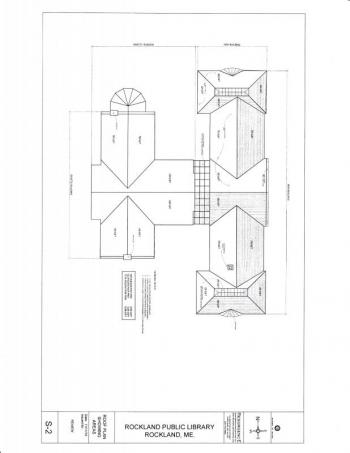ROCKLAND — Any time new moons and coastal flooding are in the forecast, water seeps into the street-level Rockland Historical Society, according to Curator Ann Morris. This occurred most recently during the October 1 rain storm, which happened to be just after an eclipse. According to Morris, the floor was dry at 10 a.m., but when high tide peaked at noon, the fire department was called to wet vacuum the Society floor.
The historical society is located in the Rockland Public Library, and the building as a whole resides on high ground between portions of Lindsey Brook Stream.
Along with sentimental Rockland histories, Morris oversees a collection of Civil War artifacts described by Society president Brian Harden as “the most valuable Civil War collection in Northern New England.”
On Tuesday, Feb. 2, engineers listened to Morris, Harden, and others who gathered to hear the engineers’ assessments of the structural integrity of the 1904 library, which is listed on the National Register of Historic Places, and its 15-year-old addition. The information provided by the engineers will be used by councilors in considering the annual budget process starting in April.
Harden also mentioned seeing an occasional stream of water running west to east through the archive room after heavy rains.
The archive room is located underneath the Reading Room. Though the historical society suffers water seeping up through the ground, the Reading Room is enduring rotting wood trusses where the wood meets stone at the ceiling level.
When the two trusses were incorporated in the structure in 1904, the wood would have been left untreated.
One hundred and twelve years of summer sun, winter snow and ice, hurricanes, overgrowth of flora, and the fact that different building materials expand at different rates may have led to cracks in the mortar and parapets, and damaged roofing.
Water, moisture, and bacteria invaded, causing hidden complications, according to Structural Engineer Eric Dube of Casco Bay Engineering and Historical Structural Engineer Alfred Hodson of Resurgence: Engineering and Preservation Inc.
The two engineers estimated a repair cost upwards of $1 million. But, understanding that municipalities need to budget, they considered priorities and phasing.
“The north wall of the original building is in some sort of failure mode,” Dube said. “....it’s a priority. High, high priority, because if you don’t do that, you’ll put yourself in a situation where you’ll be spending a lot more money.”
Dube said that other issues, such as the chimney, which is in poor shape and eroded significantly, have been addressed through the years, but not the parapets. Now those need addressing.
For immediate repairs to the new addition of the building, Hodson spoke of an isolated rotted window sill and the corner of the roof where the new and old buildings meet above the children’s garden.
“That roof has really taken a beating. I’m sure the ice, the glaciers, helped just work all that flashing apart,” Hodson said.
That roof corner is also where two gutters dispense rain water toward a very narrow drainage pipe which doesn’t catch much of the water, adding to the flooding issues in the historical society.



























